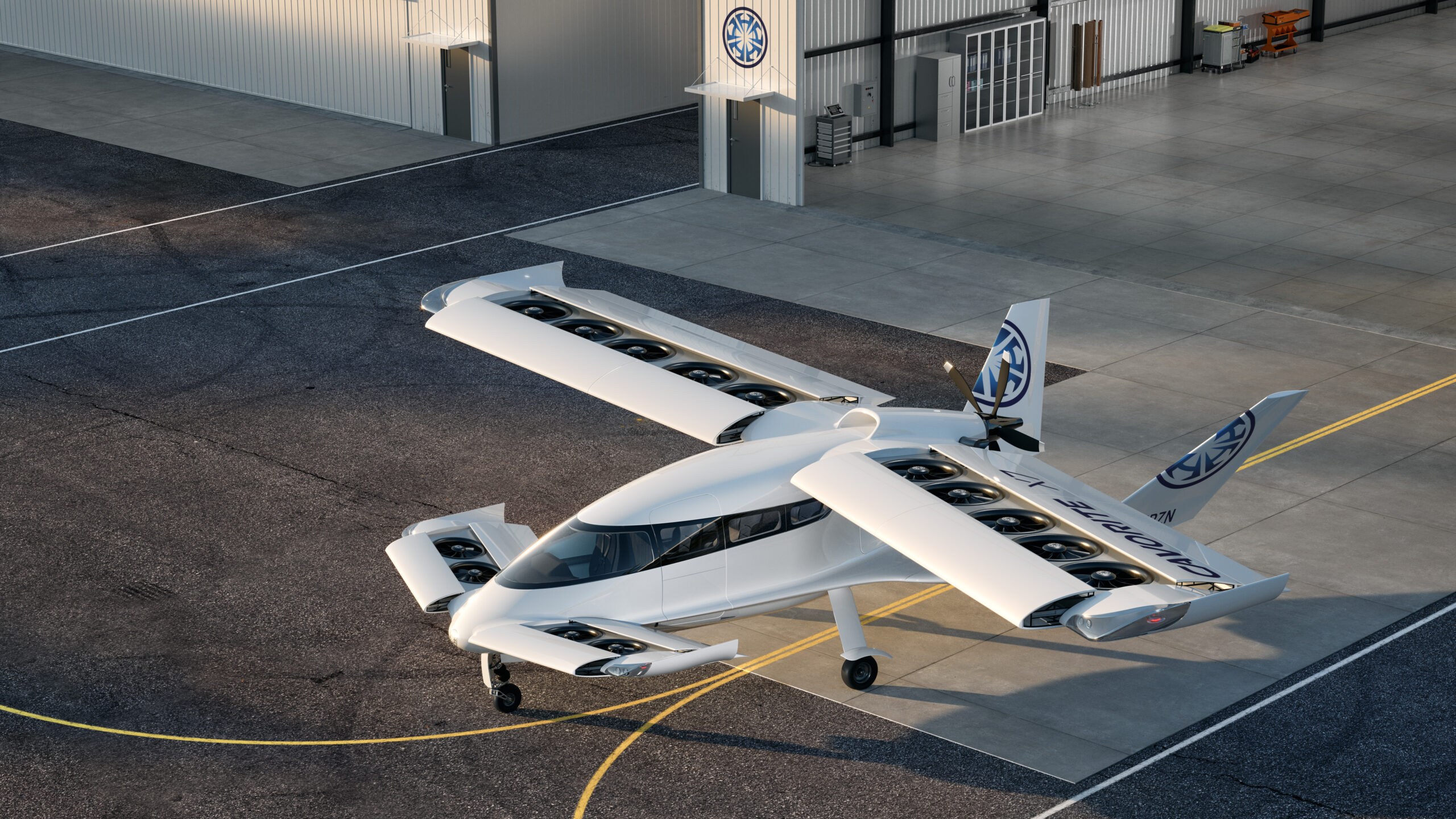Horizon Aircraft (NASDAQ: HOVR), the maker of the Cavorite X7 flagship hybrid-electric eVTOL platform that can seat 7 people (a pilot plus 6 passengers) has been heading towards the right trajectory. A “world’s first” record for an eVTOL this past May, a full-size prototype in the works, and their serious exploration into hydrogen-electric propulsion with ZeroAvia, has set them up for spectacular success in many areas, on top of their brilliant and ultra reliable hybrid-electric version of the Cavorite X7.
The Cavorite X7 stands out in the eVTOL market for 2 key reasons:
Reason #1: Horizon’s HOVR wing system.
Reason #2: Horizon’s power plant flexibility
A world first in eVTOL aviation: Transition during flight
Two months ago on the 15th of May 2025, a large scale prototype of the Cavorite X7 was the first eVTOL in the world to transition from vertical takeoff to wingborn cruise.
HOVR wing system
Horizon Aircraft developed an ingenious and patented fan-in-wing design, that admittedly, when we first learned about it at eVTOL buzz, we wondered why it hadn’t been implemented before in a hybrid VTOL or eVTOL. The idea is so brilliant and sets Horizon’s Cavorite X7 apart from its peers in the AAM industry.
The profound, yet “simplicity” in Horizon’s design is a true engineering marvel. Unlike the quadcopter-style vehicles aimed at short urban hops, the X7 is a hybrid-electric aircraft with fixed wings, a rear propeller, and 14 electric ducted fans embedded in its wings for vertical takeoff and landing. Once airborne, the fans are sealed by closing panels, allowing the aircraft to transition into efficient forward flight.
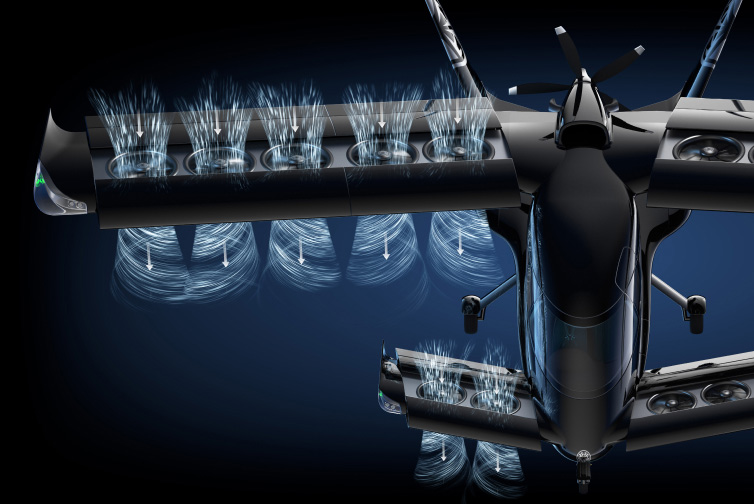
The Cavorite X7 features a revolutionary fan-in-wing design that blends the flexibility of a helicopter with the performance and speed of a traditional aircraft.
Its transforming wings house 14 high-powered lift fans, delivering the vertical thrust needed for smooth and efficient takeoff.
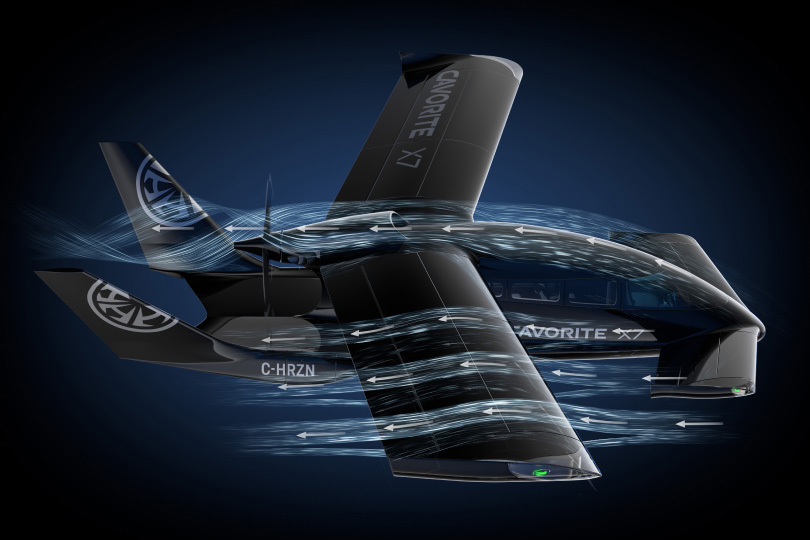
Once the Cavorite X7 reaches a safe altitude and speed, sliding panels conceal the lift fans, allowing it to transition into conventional airplane flight. For landing, it can use a standard runway, or redeploy the fans to touch down on a helipad. Horizon Aircraft claims the Cavorite X7 can even land in a space as small as a tennis court!
This fan-in-wing approach solves two problems at once: it enables true VTOL capability while retaining aerodynamic performance and range more typical of conventional aircraft.
In an interview with eVTOL buzz, the CEO and Co-Founder of Horizon Aircraft, Brandon Robinson, elaborated on their decision to pursue such a practical fan-in-wing design:
“We wanted something simple (relatively speaking), not a bunch of crazy swivel mechanisms that are hard to design and engineer. So we wanted something simple, highly redundant and safe (so if a bunch of fans failed it would not crash), and wanted something that was very efficient en route for flying… and for us, that was simple wing-borne flight, the simple pusher prop at the back, turbine engine for safety (and all the power that we need), and hybrid electric, so we weren’t severely range limited. Fuel, traditional gasoline (jet fuel), has 30 times the energy density of the best batteries (when you take into account thermal and electrical efficiencies). “……”So for every pound of gasoline you need to carry 30 pounds of batteries. So hybrid made sense to us, giving us the range and payload we want. and gives us the ability to recharge the batteries after flight and after takeoff. With a very demanding vertical phase, within 30 seconds you’re en route, then the aircraft can recharge the batteries and enter the landing phase with full battery power. We thought that was pretty compelling. You know, I come from an operational background, I used to fly jets in the Air Force, and things don’t always go the way you want to at your destination. It’s far away, the weather can change. So in the landing phase, if something happens, as long as you have fuel on board, you can circle again and recharge the battery power. For all those reasons, the configuration came out really well. ” – Brandon Robinson, CEO and CoFounder of Horizon Aircraft

Horizon Cavorite X7 ‘s max range of 800 km (497 miles) is more than 3 times as far as the Archer Midnight (161 km, 100 miles).
And that range is substantial: the Cavorite X7 is projected to travel up to 500 miles (800 km) with six passengers and a pilot on board. With one pilot and no passengers, its ferry range may approach 900 miles, according to the company.
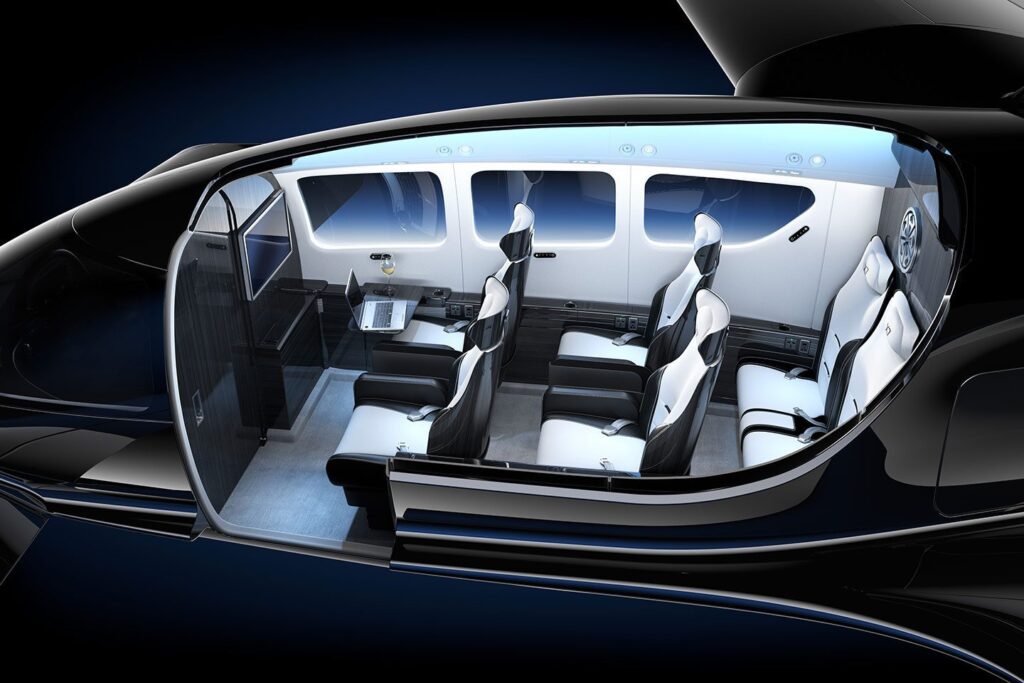

The Horizon Cavorite X7 can take 2 more passengers than the Archer Midnight and the Joby Aviation S4
Sometimes an extra 2 passengers can mean all the difference for a business trip or family outing. Having a Horizon Cavorite X7 in your fleet, there’s no need to worry about leaving someone behind waiting for the next aircraft.
Future Proof: Horizon’s power plant flexibility in the AAM market
With the current energy density of batteries not sufficient to meet the range of a hybrid electric power plant, Horizon Aircraft didn’t want to wait until an all-electric battery system could power an eVTOL for 800 KM (497 miles). They are currently building their full scale Cavorite X7 using hybrid technology, and will be ready to offer an all-electric power plant when the time comes.
The CEO and Co-Founder Brandon Robinson and Co-Founder Brian Robinson are practical pilots, engineers, and businessmen. Speaking in an interview with eVTOL buzz, CEO Brandon Robinson explained the goal of Horizon Aircraft was to design and manufacture the Cavorite X7 to be ready to use multiple types of power plants, depending what works best now, in the near future, and the distant future.
Many questions remain in the AAM industry regarding exactly when and by how much more energy dense electric batteries will become in the future, and newer and cheaper minerals/metals will become available for batteries, SAF will become cheaper / produced in significant quantities, or when hydrogen becomes the common currency for aircraft fuel. Confronting this reality head on, Horizon Aircraft’s Cavorite X7 is specifically designed with the intent to be ready to adopt a power plant fueled by the best energy source the market has to offer without dramatically altering the general design of the aircraft.
This significance cannot be sufficiently stressed! Price fluctuations in the minerals used in batteries (Lithium, etc), SAF prices, or kerosene jet fuel will be mitigated by the ability to manufacture aircraft with alternative power plants on the fly to quickly meet market demands.
“The Cavorite X7 is a hybrid electric aircraft, but that won’t always be the case. We’ve chosen this system to meet today’s needs while cutting greenhouse emissions compared to traditional aircraft conducting similar missions. But even all-electric aircraft aren’t completely emissions-free. Most of our competitors have more than 2,000 lbs of lithium batteries powering their aircraft. Modern battery manufacturing consumes large amounts of energy, toxic chemicals and immense amounts of water. For every metric ton of lithium mined, 15 metric tons of CO2 are released into the atmosphere.” – Horizon Aircraft
Currently the Cavorite X7 uses turbines which maintain the high safety and performance required for the tough missions Horizon anticipated and knew many end users would be conducting. Unwilling to compromise on safety and performance, Horizon Aircraft is ready to adopt other means of propulsion for its aircraft once those alternative technologies meet those mission critical requirements.
Another obstacle for all-electric propulsion in an eVTOL aircraft is related to outdoor temperatures and operating environments. A 2019 scientific research report from AAA in cooperation with the Automotive Club of Southern California’s Automotive Research Center (ARC) in Los Angeles, California regarding electric vehicles, found there was a 41% reduction in range when the outside temperature dropped to 20°F (negative 6.7 °C) and the heater was used. Hybrid technology using more energy dense fuels, or fuels that are less dependent on the ambient outdoor temperature is another reason why Horizon’s Cavorite X7 uses hybrid technology. As can be seen very recently with the other big player eVTOL OEMs such as Archer Aviation (with their offshoot Archer Defense), they are pursuing developing hybrid VTOLs for end users who will fly in harsher environments, particularly for obtaining military/defense contracts.
When eVTOL buzz asked Horizon CEO Brandon Robinson about the advantage of the Cavorite X7‘s hybrid technology over an all-electric platform in severe cold weather, he revealed:
“We learned that on a large scale prototype that we are testing now, and we flew it down to below zero temperatures and the batteries take a huge hit (at those lower temperatures). Something a lot of folks don’t know, say if you take off and its 15 degrees Celsius, and you go 8,000 feet up on a dry day its minus 24 degrees from the 15 [15 Celsius at ground level], so you are minus 9 degrees Celsius when you are at that 8,000 feet on a typical day. You drop about 3 degrees Celsius per every 1,000 feet for the first 10,000 feet, so its usually cold when you’re flying (the outside air temperature is). With a hybrid system on board you have bleed air for cabin conditioning, so to keep you warm. Bleed air systems are available and can be routed for de-icing and anti-icing for flying in bad weather and clouds, IFR operations, which really makes it operationally quite versatile. So now you aren’t limited to VFR flight rules. – Brandon Robinson, CEO and Co-founder of Horizon Aircraft
Such a reality regarding electric battery performance in extreme temperatures, begged the question as to whether Horizon Aircraft anticipates that many customers will be happy that even when battery technology becomes more economically viable, that an eVTOL OEM like Horizon Aircraft will remember about them and their needs in the rough environments and tough mission requirements in many parts of the world where they fly.
Brandon Robinson answered:
” So the market is going to decide. Unlike a lot of different companies that took an “if you build it they will come” approach, a lot of university think tanks, a lot of silicon valley folks with not a lot of operational experience, leveraging this all-electric wave, we come from a very operational background. There’s a lot of pilots, a lot of operational experience. My father, Chief Engineer has been flying airplanes for half a century, fixing them, building them. I’ve got 20 years in the Air Force flying jets. The first thing we did was take a hard look at the market and ask ourselves what does the market need and want. We distilled a set of specifications and built a product laser focused the end user who’s going to buy these things, and use them in a safe manner to transport all sorts of critical stuff around. People and critical goods. Starting at the beginning like that, instead of building a machine and trying to find a use for it… When you start the right way, then you end up with a product that is going to be in high demand, and ours will be absolutely. It is already in high demand.. We could have pre-sold a thousand of them already, but that’s not the route we’re choosing. ” – Brandon Robinson, CEO and Co-founder of Horizon Aircraft
Regional Shuttle Flights

Besides the obvious advantages that the Cavorite X7 holds for intercity travel such as within the “Texas Triangle” (Austin, Houston, Dallas- Fort Worth), commutes between Washington DC to NYC (342 km, 213 miles), or even flights from Washington DC to Montréal (783.8 km, 487 miles), there are numerous opportunities where the impact will be felt not only in North America, but throughout the world.
Communities that are 161 km (100 miles) or more out of range of a fully electric eVTOL will rely on the hybrid eVTOL Cavorite X7 to connect them not only to the urban areas as well as to other similar sized or remote communities without having to make a stop in a major regional hub.

Father of All Invention

It should be no surprise that Canada 🇨🇦 is the home of this creative and innovative aircraft manufacturer Horizon Aircraft, which was founded by the father and son team Brian and Brandon Robinson. While known for its major metropolises such as Toronto and Vancouver, Canada is equally known for her vast swaths of land that are quite difficult and costly to reach by conventional transportation. Necessity is the mother of all invention, but this time it took a father and son team to fill this need within the AAM aviation industry. The solution provided by Horizon’s Cavorite X7 will undoubtedly be much appreciated in many parts of the world, from the tundras of Canada to the deserts of Arizona, and the fjords of Norway to the tropical rainforests of Ghana.
A July 2024 white paper from the World Economic Forum and Kearney (the global management consulting firm), touches on the impact AAM will have on remote regions by improving their access and lowering their risk in transportation.

The World Economic Forum has launched AVIATE: Advanced Air Mobility initiative to support the integration of AAM technologies, and is part of the WEF’s Centre for the Fourth Industrial Revolution
Key areas that the World Economic Forum has focused on related to AAM are:
- Healthcare
- Connecting Remote Locations
- Urban Transport
Medical Needs

Source: Horizon Aircraft
The World Economic Forum‘s white paper stresses Advanced Air Mobility (AAM) use cases pertaining to healthcare, like patient emergency flight, lab sample delivery, organ transplant, or medical inventory transportation, are anticipated to be initially adopted in a wide scale commercially. Better, quicker, and less expensive medical services are provided by AAM, which may make it possible for facilities to share inventories and medical supplies in real time. This can lessen the impact on both developed and emerging economies’ healthcare resources and provide flexibility in meeting the emergency and non-emergency healthcare needs of the communities in which they serve. As a result, the public strongly supports these applications since they directly affect the effectiveness and accessibility of healthcare. Additionally, because such technology is clearly applied “for public good,” they increase the sector’s appeal to entrepreneurs and their investors.
When eVTOL buzz asked about Horizon Aircraft’s unique ability to serve these roles with their Cavorite X7, Brandon Robinson explained:
“I think there are tons of missions right now, like EMS, organ transport, getting people to the hospital in a safer, faster manner, reaching out and delivering critical goods to remote communities, disaster relief. Rolling in and helping out with a hurricane, and you can deploy quicker and a much more economical fashion so it doesn’t cost as much…. some specific fire missions.. There are a lot of missions right now….. and again it comes down to the mission first. There’s a lot of very cool missions right now that these machines [Cavorite X7] can do, Those missions require economics, speed, payload, those sorts of things. But it does start with mission first.” – Brandon Robinson, CEO and Co-founder of Horizon Aircraft
Brandon Robinson made it known throughout the interview, that Horizon Aircraft’s hybrid eVTOL, the Cavorite X7, was made after carefully accessing what was truly needed by many operators in the AAM sector.

At 450 km/hr (280 mph) the Cavorite X7 can fly at almost twice the speed as the Archer Midnight (241 km/hr, 150 mph)
When seconds count in emergency medical situations, speed matters!
At 450 km/hr (280 mph), Horizon’s Cavorite X7 hybrid eVTOL aircraft will get the patient to the hospital quicker than it’s fully-electric competitors.
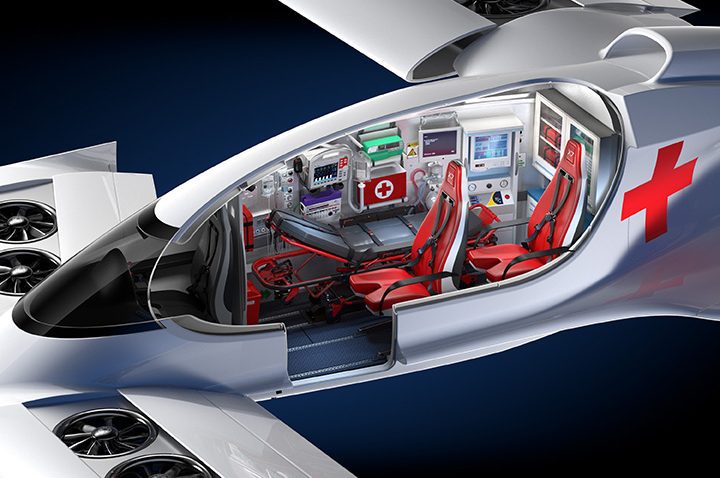
Medical use cases are paving the way for most other AAM sectors benefitting from its positive societal impact. Emerging economies are likely to roll out these applications on a wider scale first (e.g. India) as they have a higher proportion of underserved areas (with underdeveloped infrastructure and medical supply chains). Notwithstanding this, developed countries will also benefit, e.g. in cases of natural catastrophes.
Source: Buckup, S., & González, J. (2024). Advanced Air Mobility: Shaping the future of aviation. In Kearney and World Economic Forum, WHITE PAPER
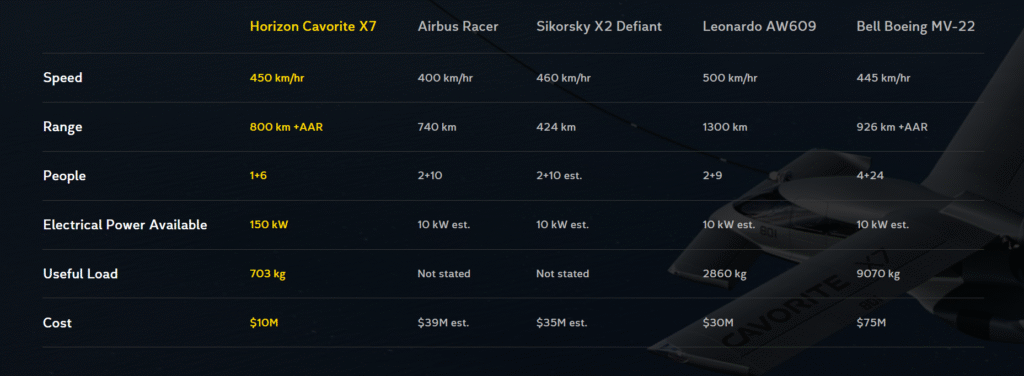
The Horizon Cavorite X7 also compares favorably to other, more expensive long-distance conventional VTOL aircraft in speed, yet at a fraction of the cost. Such a more affordable price entry point for long-distance VTOL aircraft will allow municipalities, non-profits, and many more communities to serve their populations with critical medical transport, evacuation services, and search and rescue. Current realities such as aging populations requiring greater medical services, or the increase in adverse weather and forest fires (which may be caused by climate change) will only cause a greater demand for such aircraft as the Horizon Cavorite X7.
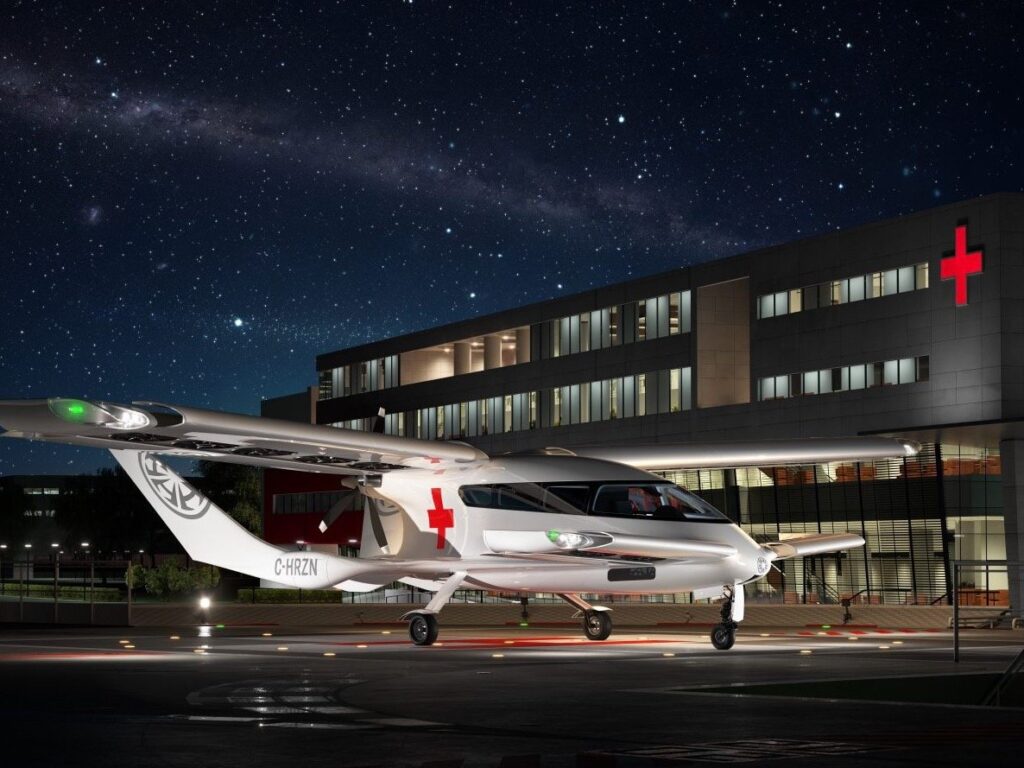
Connecting Communities:

According to NASA’s Aeronautics System Analysis Branch, 30 out of the 5,000 plus airports (0.6%) in the United States serve 70% of all air travelers. This will inevitably change. Most people in the United States live within 16 minutes of an airport, yet 5,050 of these airports are severely under-utilized. Only 1.6 % of trips between 50 and 500 miles are taken by aircraft.
eVTOLs like Horizon’s Cavorite X7 will provide an incentive for greater utilization of existing airfields and airports.
Remote and Rural Locations
“Say you are a northern community in Canada. You’re relatively isolated and generally rely on ice roads. Because the world is getting warmer, they are only open for 6 weeks in the winter now. So now, all you need is a flat area to land, and you are good to go. The key there is about economics. About 75% cheaper than a helicopter per unit mile. It’s pretty compelling to connect some of those northern communities. Around the world too, where there’s not the ground infrastructure. Why build and maintain billions of dollars worth of road when you can now just reach out and touch these communities.” – Brandon Robinson, CEO and Co-founder of Horizon Aircraft
A side note, is that AAM can help decrease the amount of unnecessary road construction, and prevent further disruption of wildlife habitat, and lessen roadkill hazard by flying over forests and mountains rather than disrupting the natural landscapes in order to connect communities. This also avoids the use of eminent domain to seize property from farmers and ranchers for the construction of rural highways.

Urban Air Mobility
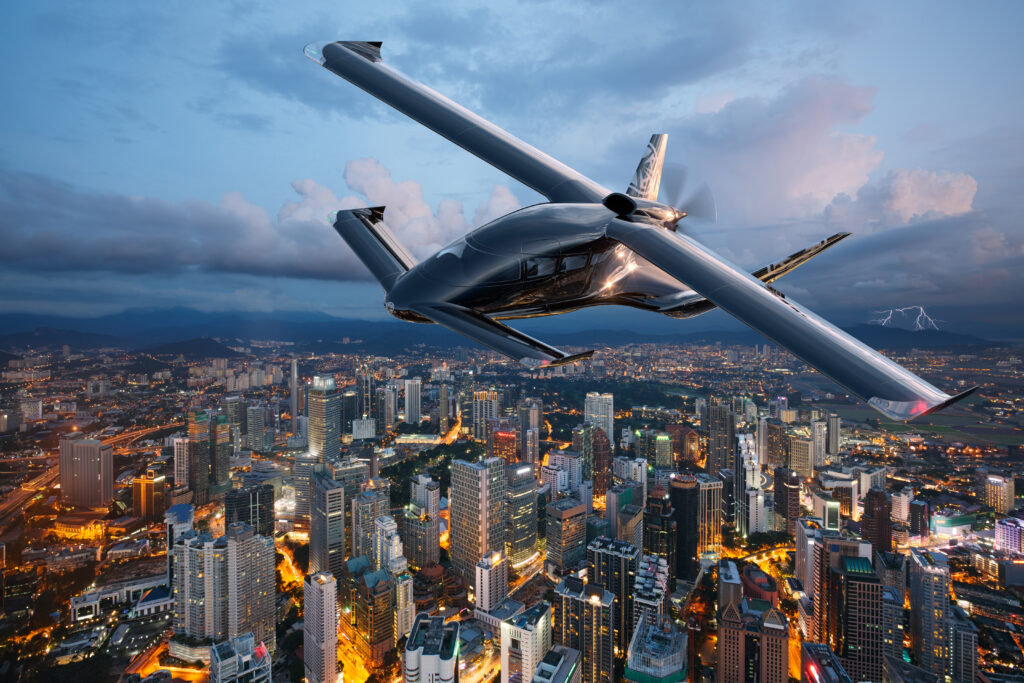
Air taxis may not be the primary focus of Horizon Aircraft (which has filled the AAM niche of intercity travel); nevertheless, for an operator that is willing to buy an aircraft that can be an urban air taxi one day, and an intercity shuttle the next day, the Cavorite X7 is a multirole eVTOL built to be used for virtually any purpose an operator might need within UAM and AAM.
Taking a VIP to a downtown vertiport for a posh business dinner or transporting some critical high value machine parts from a specialized machine shop to a factory or offshore oil platform in time to save the day is all possible with the Cavorite X7.
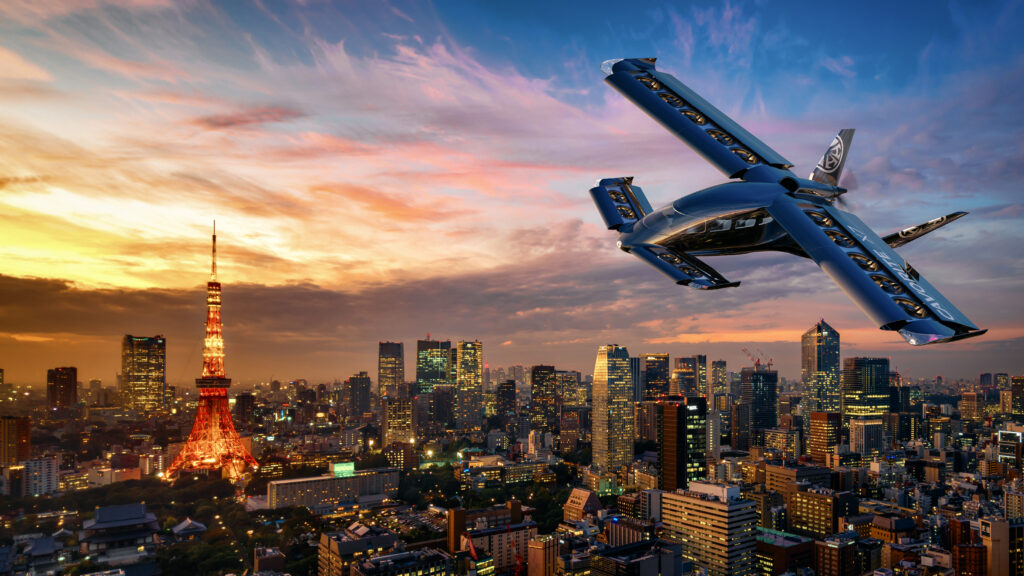
What’s next?
Being ahead of the game with hybrid eVTOL designs, now Horizon Aircraft wants to explore the emerging hydrogen propulsion tech — and that’s where ZeroAvia comes in.
However, battery technology is improving rapidly in terms of both energy and power density. And of course hydrogen remains an interesting possibility as logistical challenges are met with innovative solutions. The Horizon Aircraft team is monitoring both of these possibilities and is charting a path for an even more sustainably powered future. – Horizon Aircraft
Hydrogen-Electric Flight: From Concept to Cockpit
ZeroAvia is no stranger to headlines. The California- and UK-based startup has racked up achievements over the past three years, including the successful flight of its 19-seat Dornier 228 testbed powered by its ZA600 hydrogen-electric engine.
World’s first hydrogen fuel cell-powered commercial grade passenger aircraft flight
In September 2020, ZeroAvia became the first to succesfully fly a hydrogen-electric powered passenger plane, which was a converted Piper M-class, a 6 passenger seater + pilot aircraft (similar in size to Horizon’s Cavorite X7). It took off from ZeroAvia’s R&D facility at the world famous Cranfield Airport, in the UK and made a full pattern circuit before landing back at Cranfield Airport.
The ZA600 is a 600-kilowatt fuel cell-based powertrain intended for aircraft in the 9–19 seat category — not far off from the Cavorite X7’s size class. It uses hydrogen to produce electricity, with only water vapor as the byproduct.
Speaking about the collaboration between Horizon Aircraft and ZeroAvia, Val Miftakhov, the CEO of ZeroAvia noted:
“Our hydrogen-electric system offers the power and endurance needed for serious regional missions…This partnership is about applying that technology to an entirely new kind of aircraft — one that blends vertical lift with fixed-wing performance.” – Val Miftakhov, ZeroAvia CEO
The company is currently pursuing certification for the ZA600 with the UK’s CAA and the FAA in the U.S., targeting commercial entry around 2026. It has also logged pre-orders from major airlines including American Airlines, Alaska Airlines, and United, with over 2,000 engine reservations to date.
The agreement brings together Horizon’s fan-in-wing vertical lift design with ZeroAvia’s proven hydrogen fuel cell technology, marking one of the most high-profile efforts to fuse eVTOL design with a zero-emission, long-range power source.
“More and more eVTOL companies are looking to hydrogen-electric propulsion as the breakthrough that can extend range potential and durability of electric propulsion systems. Horizon Aircraft has developed an exciting application and performed successful prototype testing, and they are taking another leadership step in exploring hydrogen as a potential propulsion option for the Cavorite X7.” – Val Miftakhov, Founder & CEO, ZeroAvia
Why It Matters: More Than Just a Tech Demo
While many eVTOL concepts are focused on urban air mobility (UAM) — think short-hop air taxis flying five to 25 miles — Horizon’s aircraft is built for regional flights of 100 to 500 miles. That difference dramatically shifts the propulsion equation.
For short hops, lithium-ion batteries suffice. For long-range, payload-heavy missions, they become a liability without wingborne flight.
Hydrogen, on the other hand, offers up to a much higher energy density than current battery tech. And where recharging batteries can take hours to store enough energy to go past 300 miles, hydrogen can be refueled in minutes (about as quickly as refueling with jet fuel) — a key advantage for high-utilization operations such as emergency services, medevac, logistics, and regional shuttle flights.
In 2023, ZeroAvia claimed:
“Hydrogen has 15-50 times more energy density than the best electric batteries today . This means that, where batteries struggle to deliver payload and range for most commercial applications of an electrified [Cessna] Caravan, fuel cells can overcome that challenge” – ZeroAvia brochure titled: The Hydrogen-Electric Cessna Grand Caravan
Add to that the ability to operate from both airports and compact landing zones, the Cavorite X7 positions itself as a uniquely capable platform that bridges the gap between helicopters and turboprops — now with a potentially zero-emission power source!
The Crossover: From Hybrid-Electric to Hydrogen-Electric
Horizon’s current Cavorite X7 prototype uses a hybrid powertrain combining electric motors with a combustion-based turbine range extender. The aircraft can take off vertically, then cruise using traditional propulsion.
Integrating the ZA600 would allow Horizon to eliminate fossil fuel use entirely — a shift that aligns with broader aviation sustainability goals, and may open new regulatory and operational pathways for zero-emission air transport.
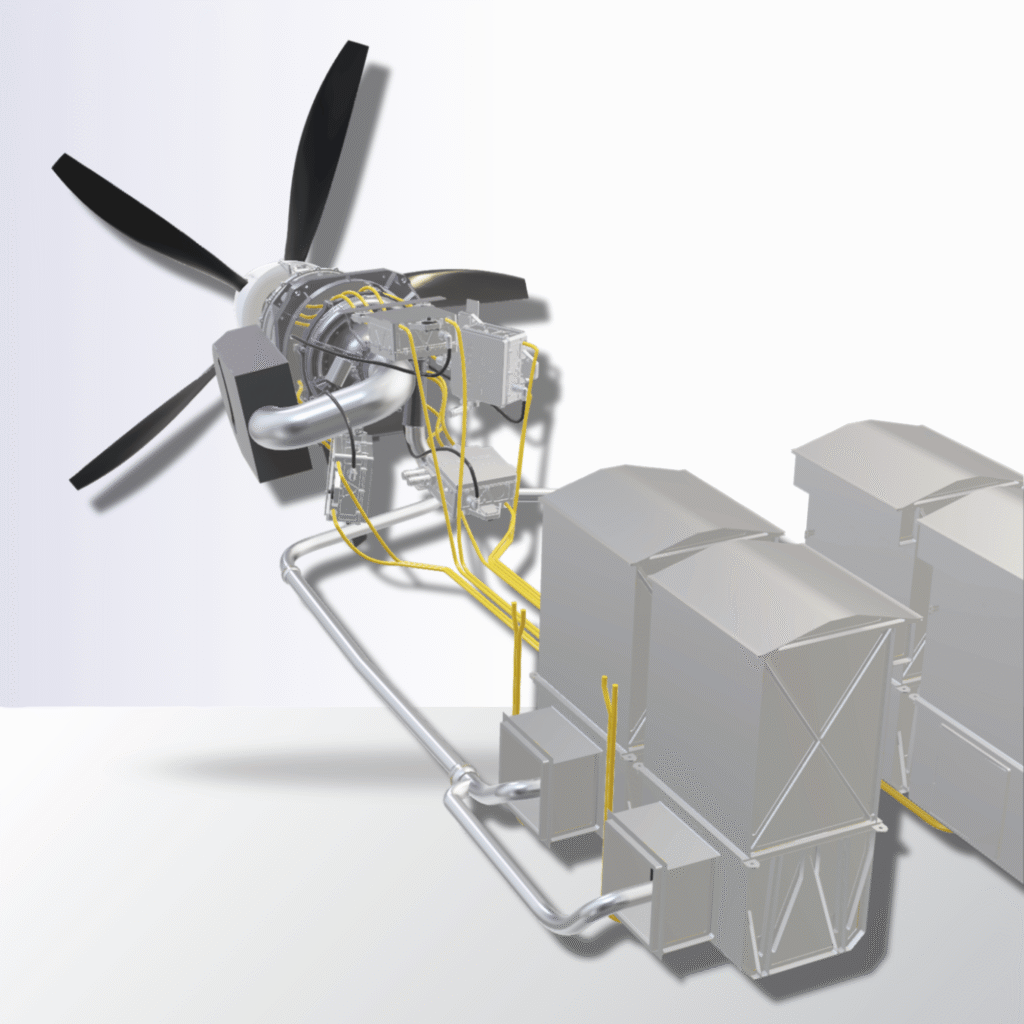
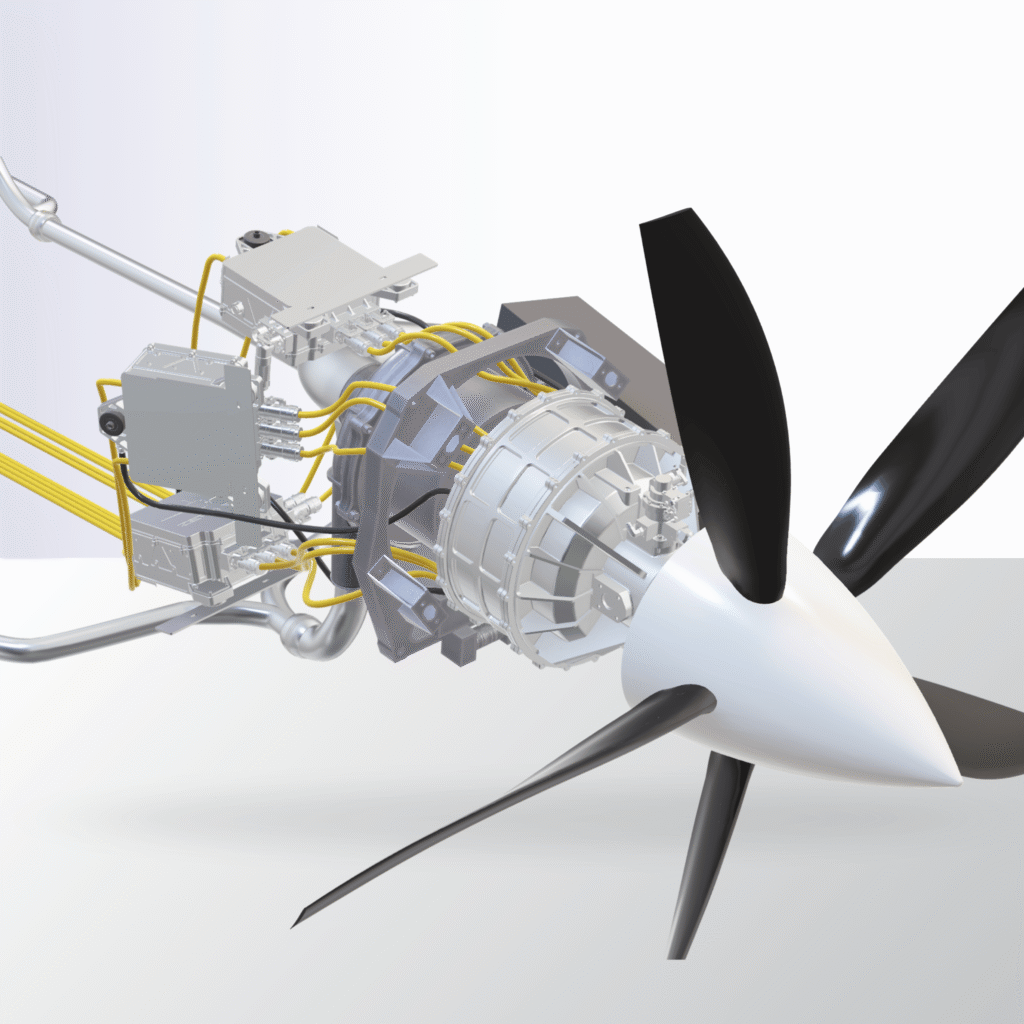
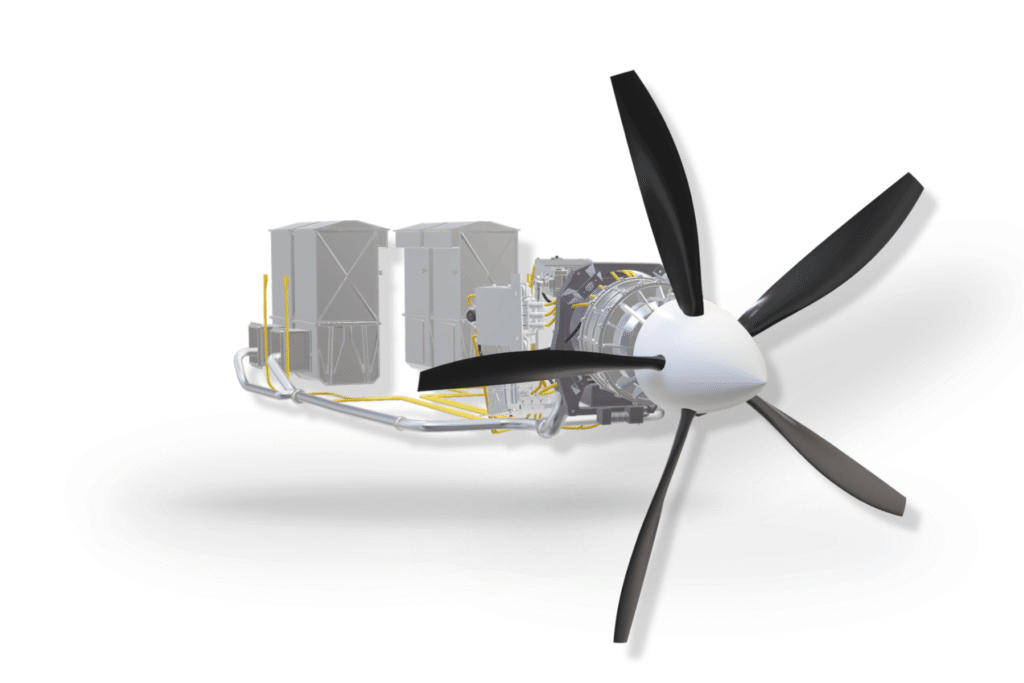
ZeroAvia’s ZA600 hydrogen electric powertrain (to be used in the hydrogen version Horizon Cavorite X7 )
“We are a company that continues to focus on what is best for operators of our aircraft. We have been impressed with ZeroAvia’s recent flight demonstrations of hydrogen-electric propulsion systems and the company’s traction with regulators. We are thankful for the opportunity to explore hydrogen solutions for the regional air mobility market which could develop into a viable solution to deliver clean, fast, and highly-efficient air travel.” – Brandon Robinson, Horizon Aircraft CEO
The integration is still in the exploratory phase, with engineering teams now analyzing how the ZA600’s power and cooling requirements could be adapted to the X7’s unique geometry and mission profile.
“More and more eVTOL companies are looking to hydrogen-electric propulsion as the breakthrough that can extend range potential and durability of electric propulsion systems. Horizon Aircraft has developed an exciting application and performed successful prototype testing, and they are taking another leadership step in exploring hydrogen as a potential propulsion option for the Cavorite X7.” – Val Miftakhov, Founder & CEO, ZeroAvia
The Infrastructure Equation:

Hydrogen Airport Refueling Ecosystem (HARE)
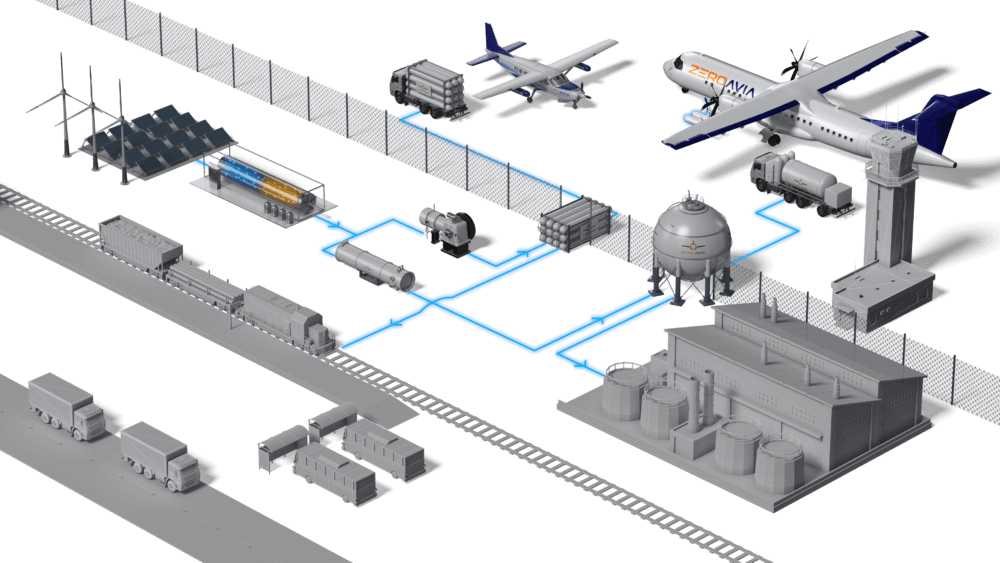
Of course, no hydrogen aircraft can fly without ground-side infrastructure.
As part of their agreement, Horizon and ZeroAvia will also work together to study hydrogen fueling logistics, including:
- On-site hydrogen production and storage
- Mobile refueling systems for remote operations
- Safety protocols for VTOL and airport environments
- Turnaround time and ops modeling for fleet services
Airports for research, testing, and hydrogen energy hubs:
ZeroAvia is already piloting hydrogen hubs at regional airports in the UK, California, Canada, France and the Netherlands, with plans to scale this ecosystem globally as aircraft adoption ramps up.
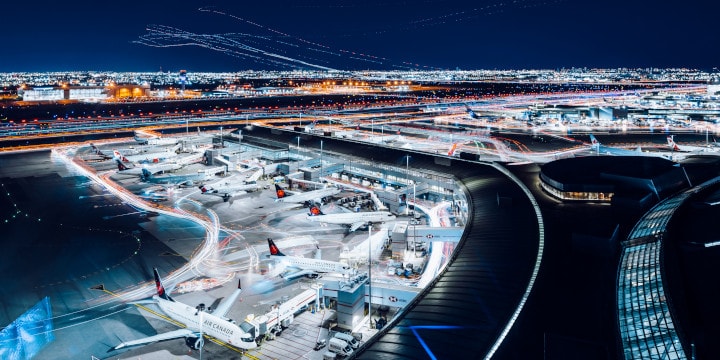
Toronto Pearson International Airport (YYZ), in Toronto, Canada 🇨🇦
- ZeroAvia will build a hydrogen filling station at the Toronto Pearson International Airport (YYZ)
“Toronto Pearson is committed to making our own operations and those of the larger aviation industry more sustainable. Our partnership with Airbus and ZeroAvia is an extension of our ongoing efforts to adopt clean energy solutions, including the construction of our new hydrogen filling station.”….“The future of airports and their aviation partners will be built with innovative infrastructure that minimizes environmental impact.” – Deborah Flint, President and CEO of Toronto Pearson
“We are bringing together Canada’s largest airports, the world’s largest aircraft manufacturer and the leading innovator in decarbonised propulsion technology, in order to progress the transition to hydrogen aviation. ZeroAvia flight testing demonstrates that hydrogen-powered commercial aviation is a prospect ahead of 2030, so we need to start working hard to prepare for the hydrogen infrastructure needed to support the aviation industry and airports as they step into a new golden age of clean flight.” – Val Miftakhov, Founder and CEO, ZeroAvia

ADM Aéroports de Montréal 🇨🇦
- ZeroAvia will work with Aéroport International Montréal-Trudeau and Aéroport international Montréal-Mirabel to make the airports infrastructure ready for hydrogen fueling as early as 2035
“ADM is committed to decarbonizing airport operations and improving air quality at its YUL and YMX sites. The use of hydrogen as a fuel for aircraft is a forward-looking solution that fits perfectly with these goals. This partnership will allow our organization not only to better prepare for the introduction of this alternative in our airport operations, but above all to adequately plan the infrastructure required to offer it at YUL as early as 2035. As Montréal is the world’s civil aviation capital, we are all the more proud that our city is playing a leading role in this sustainable innovation project.” – Yves Beauchamp, President and CEO of ADM Aéroports de Montréal

Edmonton International Airport (EIA) in Edmonton, Canada 🇨🇦
- ZeroAvia will cooperate with Edmonton International Airport to work on hydrogen powered aircraft infrastructure to decarbonize air and ground operations.
- Starting with gaseous hydrogen, eventually using liquid hydrogen for aircraft above 20 seats.
- Advance experience from ZeroAvia’s Hydrogen Airport Refuelling Ecosystem (HARE)
“Edmonton International Airport has been a leader in pushing the envelope in efforts to tackle emissions using innovative technology. The massive renewable installation, natural resources, flight operations and administrative autonomy, makes EIA a great partner for us.” – Arnab Chatterjee, VP Infrastructure, ZeroAvia
“We are excited to work with ZeroAvia, a global leader in zero-emission aviation. We believe that hydrogen will be a key technology to decarbonize aviation and airport operations for a net-zero future. ZeroAvia’s innovations, achievements, and shared values made it natural for us to develop a collaboration. Airports can help drive the adoption of hydrogen, thereby reducing emissions and improving air quality across the scope of their operations and beyond.”– Myron Keehn, VP, Air Service, Business Development, ESG, and Stakeholder Relations, Edmonton International Airport
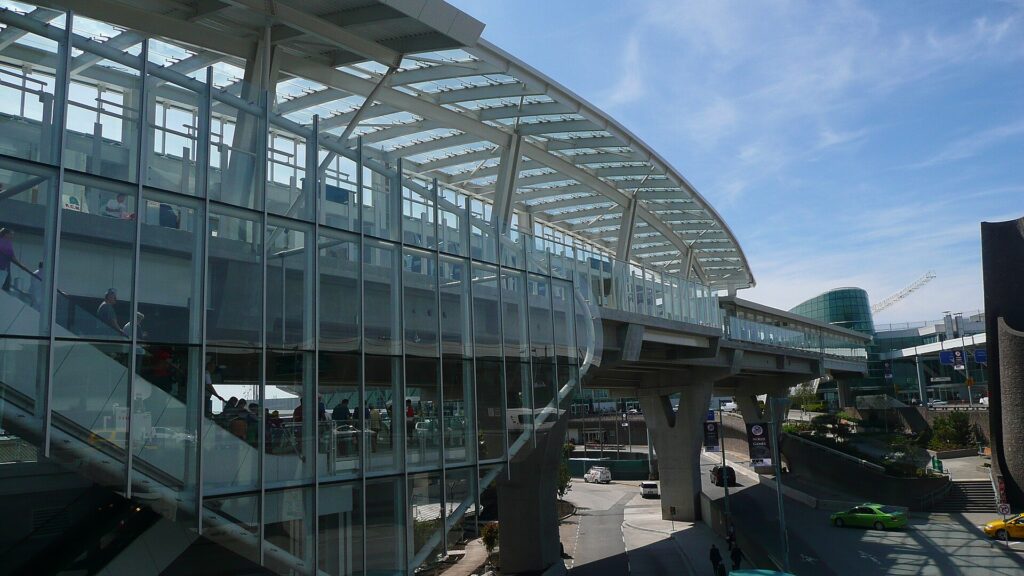
Vancouver International Airport (VYR) in Vancouver, Canada 🇨🇦
“We know when it comes to climate change, aviation isn’t the enemy, carbon is. Looking into the feasibility of airports as Hydrogen Hubs is an important step on the journey to net zero carbon emissions.“….“The collaboration between Airbus, ZeroAvia and the three biggest airports in Canada will help identify the changes required in our industry and supporting ecosystem to meet carbon reduction goals.” – Tamara Vrooman, President and CEO at Vancouver International Airport
Kearney and the World Economic Forum explain the significant of recharging and refueling of eVTOLs at vertiports and their natural progression into energy hubs:
Recharging or refueling: Charging stations should ensure seamless operations, since AAM vehicles are mostly electric. Charging stations rely on grid connection, sufficient capacity and high charging quality – making energy players key stakeholders. Ideally, vertiports offer more than just electric charging points and are also equipped to accommodate alternative energy options such as hydrogen and biofuel, or battery swapping infrastructure. Thus, vertiports become energy hubs.
Source: Buckup, S., & González, J. (2024). Advanced Air Mobility: Shaping the future of aviation. In Kearney and World Economic Forum, WHITE PAPER
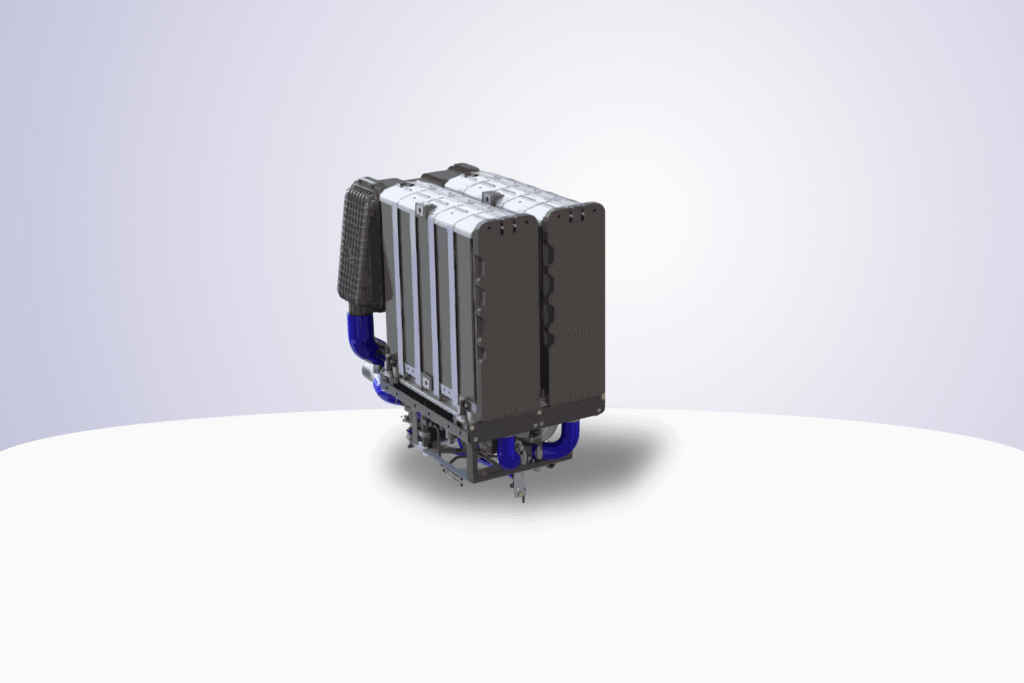
SuperStack Flex (LT-PEM)
- To be utilized in the Cavorite X7 (hydrogen version)
- Suited for VTOL and UAV aircraft
- Specific Power: 1.5kW/kg Power
The Road Ahead
While no flight timeline has been announced, both companies say they are committed to advancing the integration program in parallel with their own flight test and certification milestones.
Once ZeroAvia mass produces its ZA600 hydrogen electric powertrains for OEMs, hopefully the cost lessened due to scale of economy, as well as a reduction in hydrogen refueling costs, will help Horizon Aircraft keep a hydrogen powered version of their Cavorite X7 relatively affordable compared to its peers in the industry (against the pressures of inflation), and allow the hydrogen version Cavorite X7 to serve vital roles that it was designed for, and be accessible to many non-profits, EMS, search and rescue teams, small businesses, rural communities and urban communities alike. The profits made from large order defense contracts, offshore energy/oil rigs, and VIP & business executive sales, can be used to put more investment back into Horizon Aircraft. Furthermore, great interest in both the hybrid-electric technology already developed by Horizon Aircraft, and the hydrogen-electric technology it is currently pursuing should encourage many investors to become shareholders of Horizon Aircraft (NASDAQ: HOVR), which will become a large scale OEM as soon as operators are able to purchase these incredible aircraft and start flying them.
Currently, Horizon is already preparing for full-size prototype flight testing of the Cavorite X7 following successful subscale and static testing achievements made this year in 2025.
Bottom Line: A Bold Step Toward Real-World eVTOL Utility
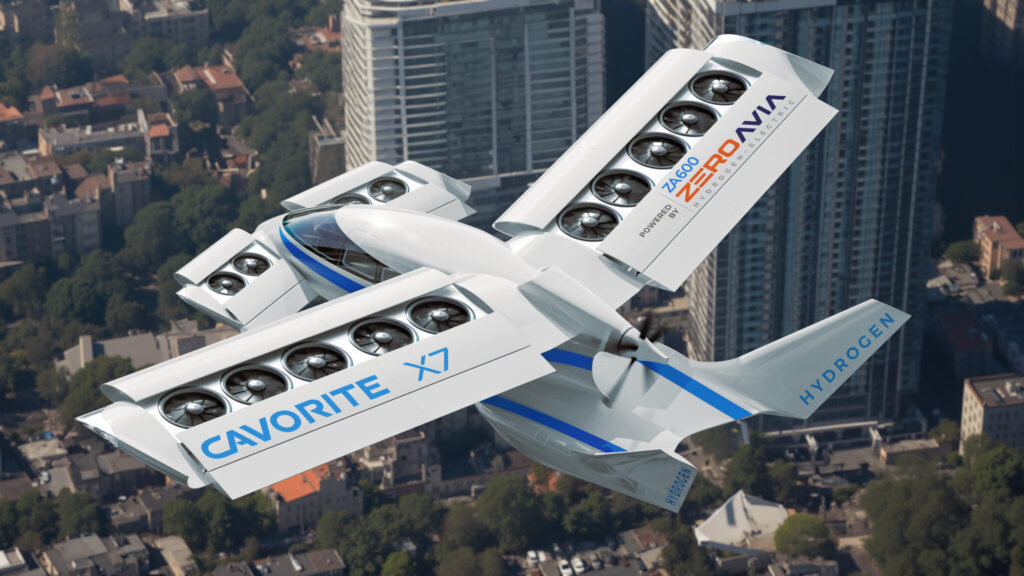
When completed, Horizon Aircraft’s hybrid-electric Cavorite X7 will become a game-changer — not just in the air, but in how the world thinks about the future of flight. The Cavorite X7’s unique multirole mission design will undoubtedly lead to its success and ubiquitous prevalence in the skies across the world. Made in mind to take you to the boardroom or the frontier, and anywhere in between. The hybrid-electric version of the Cavorite X7 will be able to fly from anywhere jet fuel is available, charge the batteries en route and land with full battery power.
As more airports get serious about hydrogen powered aircraft and the infrastructure required to fuel them, it will allow OEMs like Horizon Aircraft to consider producing a hydrogen powered version. The current hybrid-electric Cavorite X7 will be greener than any existing long-range VTOLs at its onset. A hydrogen version of the Cavorite X7 developed some time in the future, will make it even more greener! $💵🌎 The beauty of Horizon’s Cavorite X7 is that it’s design can be adapted to different power plants as they become practical and do not conflict with Horizon Aircraft’s core mission of never compromising on safety and performance!
✈️ Stay tuned to eVTOL buzz for test flight updates, tech deep dives, and exclusive interviews as this story evolves.
More Info:
Horizon Aircraft official website: click here
Horizon Aircrafts official youtube channel: click here
Horizon Aircraft’s official press release: click here
ZeroAvia’s official press release: click here
ZeroAvia to Build Manufacturing Hub in Scotland: click here
ZeroAvia Awarded UK Government Grant for Development and Flight Test of Liquid Hydrogen Fuel System: click here
ZeroAvia Awarded UK Government Grant to Progress Advanced Fuel Cell R&D for Clean Aviation: click here
Press release – ZeroAvia Completes World First Hydrogen-Electric Passenger Plane Flight: click here
ZeroAvia Commences Liquid Hydrogen R&D Activity at Stockton Metropolitan Airport: click here
ZeroAvia Awarded California Energy Commission Grant to Develop High Efficiency Liquid Hydrogen Refueling Trucks: click here
EMEC (European Marine Energy Centre) official press release regarding the the HyFlyer truck: click here
Partnership between ZeroAvia, Royal Schiphol Group and Rotterdam The Hague Innovation Airport: click here
ZeroAvia, Shell, RHIA and Rotterdam The Hague Airport advance Plans for Hydrogen-Electric Flights by 2025: click here
Fuel Cell Systems Official website: click here
World Economic Forum – Technology pioneers: click here
Advanced Fuel Cell for Aviation Decarbonisation (AFCAD) project: click here
Cranfield supports ZeroAvia’s world first hydrogen-electric passenger aircraft flight: click here
Airbus and ZeroAvia Partner on Hydrogen Hubs at Leading Canadian Airports: click here
ZeroAvia & Edmonton International Airport Tie Up to Bring Hydrogen-Electric Flights to Canada: click here
ZeroAvia and Birmingham Airport Plan for Zero-Emission Flights: click here
ZeroAvia Awarded UK Government Grant for Development and Flight Test of Liquid Hydrogen Fuel System: click here
ZeroAvia Granted Raft of New Patents Key to the Development of Large Hydrogen Aviation Engines: click here
AAA: Icy Temperatures Cut Electric Vehicle Range Nearly in Half: click here
ZeroAvia Makes Major Strides in Hydrogen Refueling with Shell Collaboration and Airport Pipeline Launch: click here
#fcff7d

